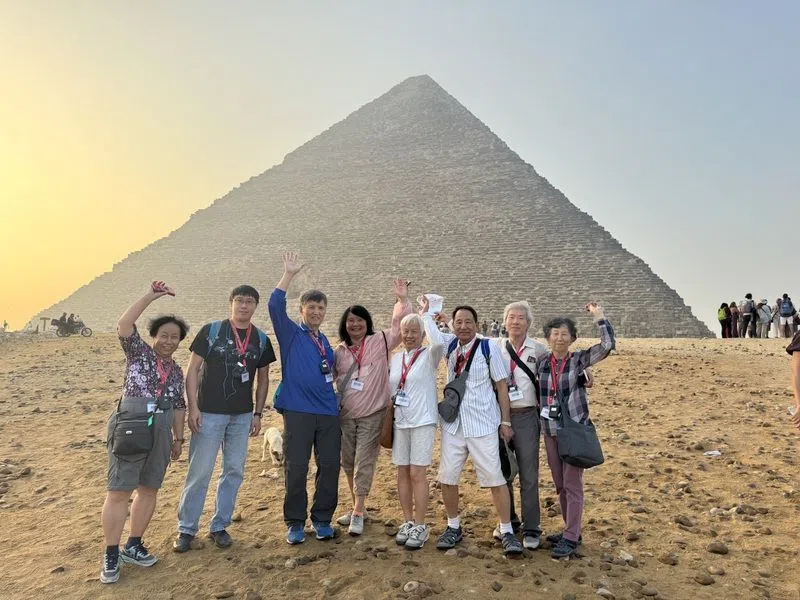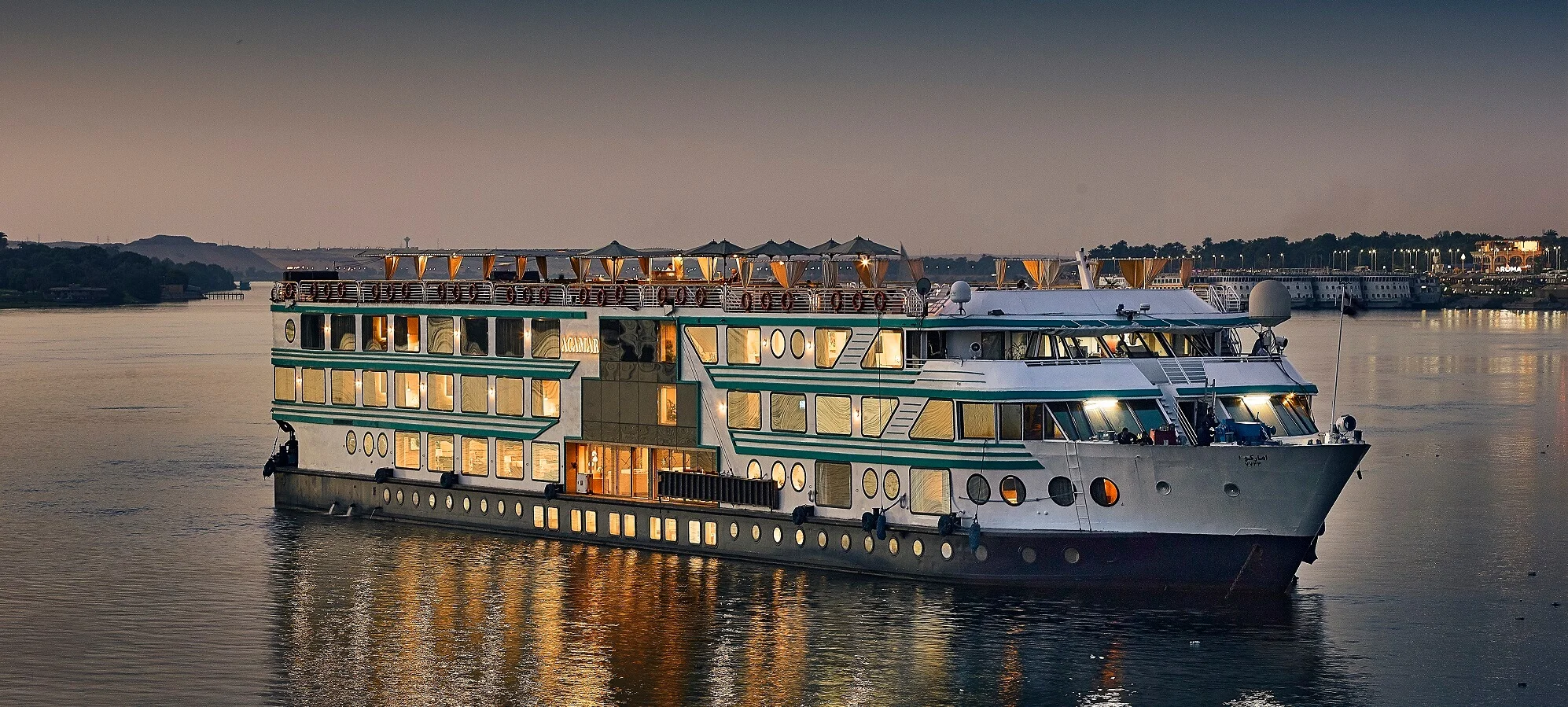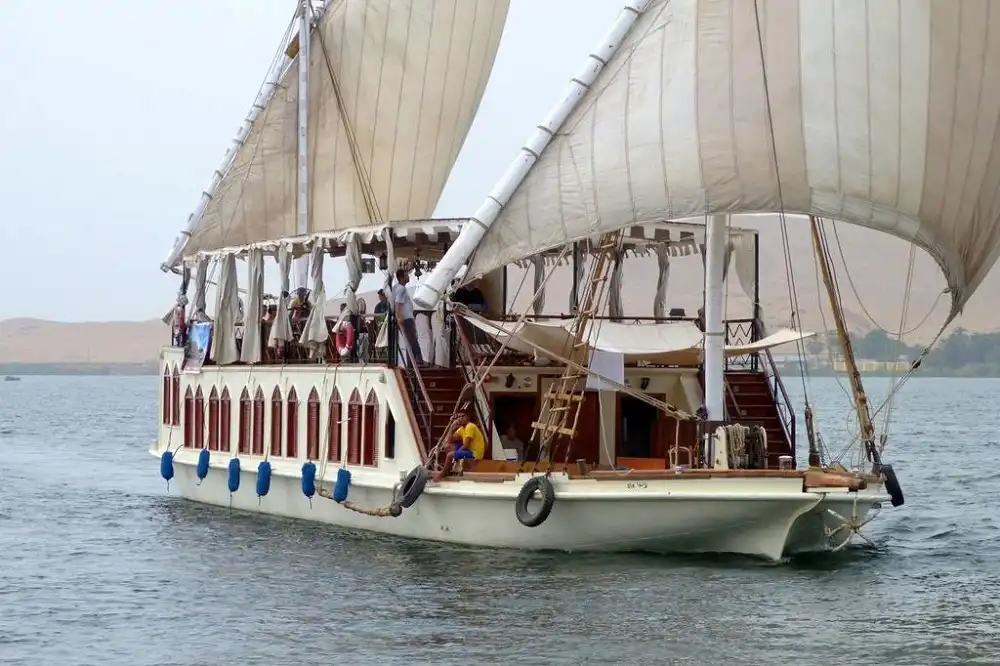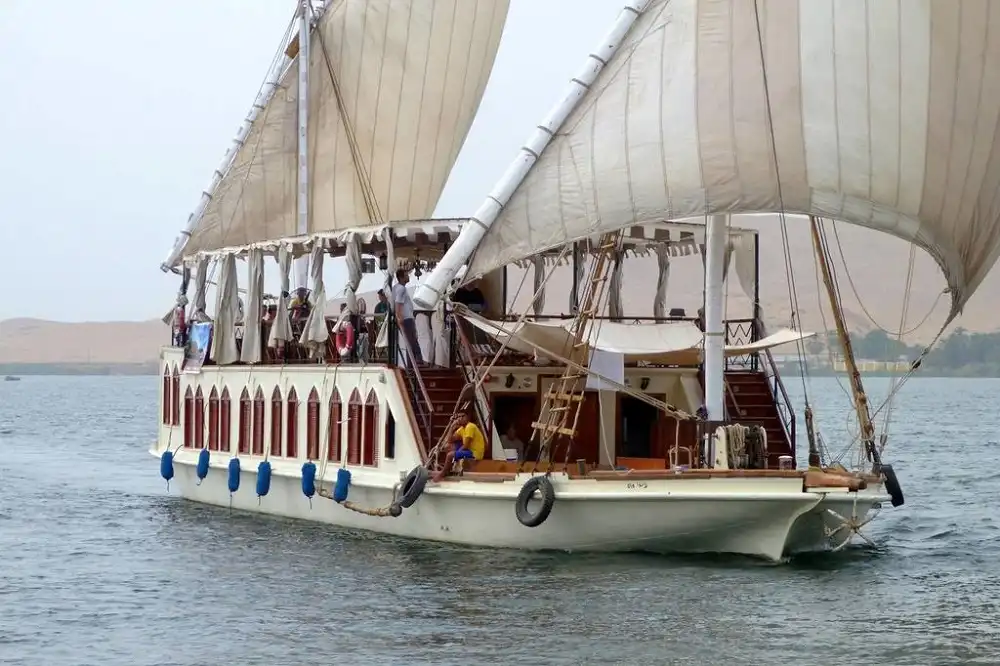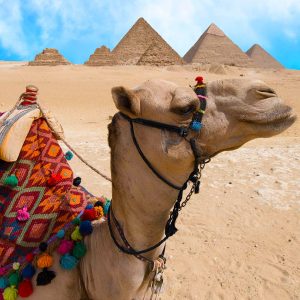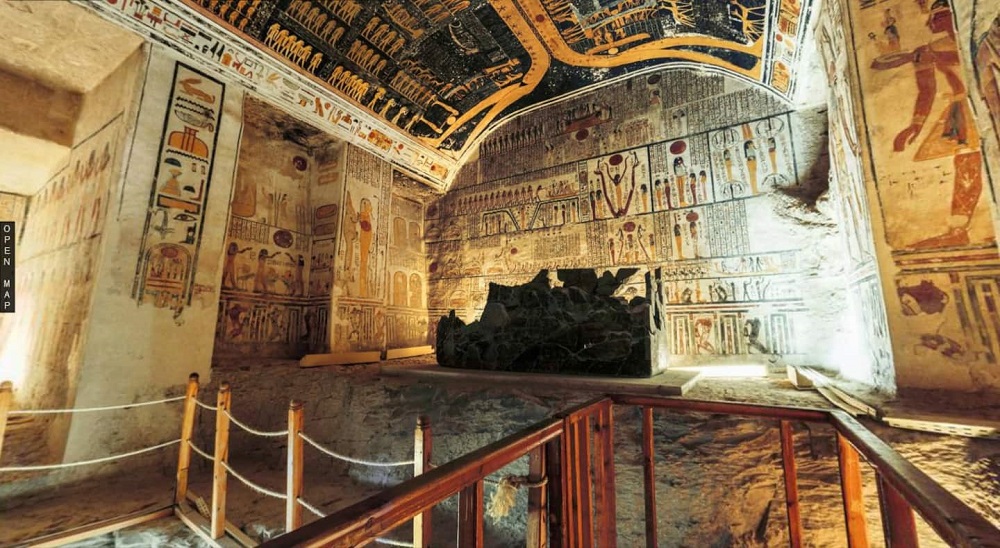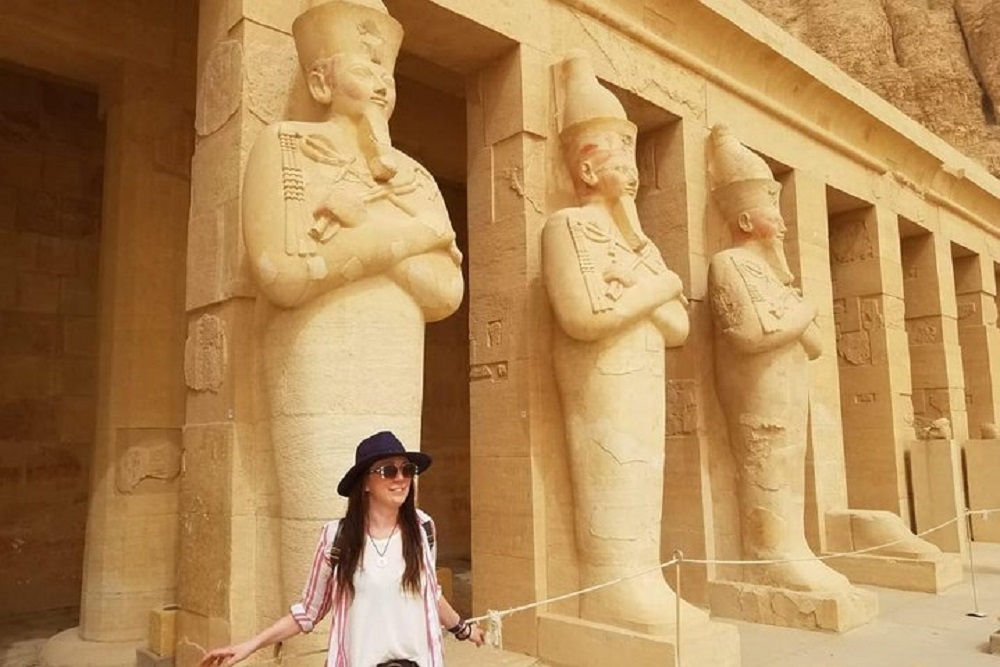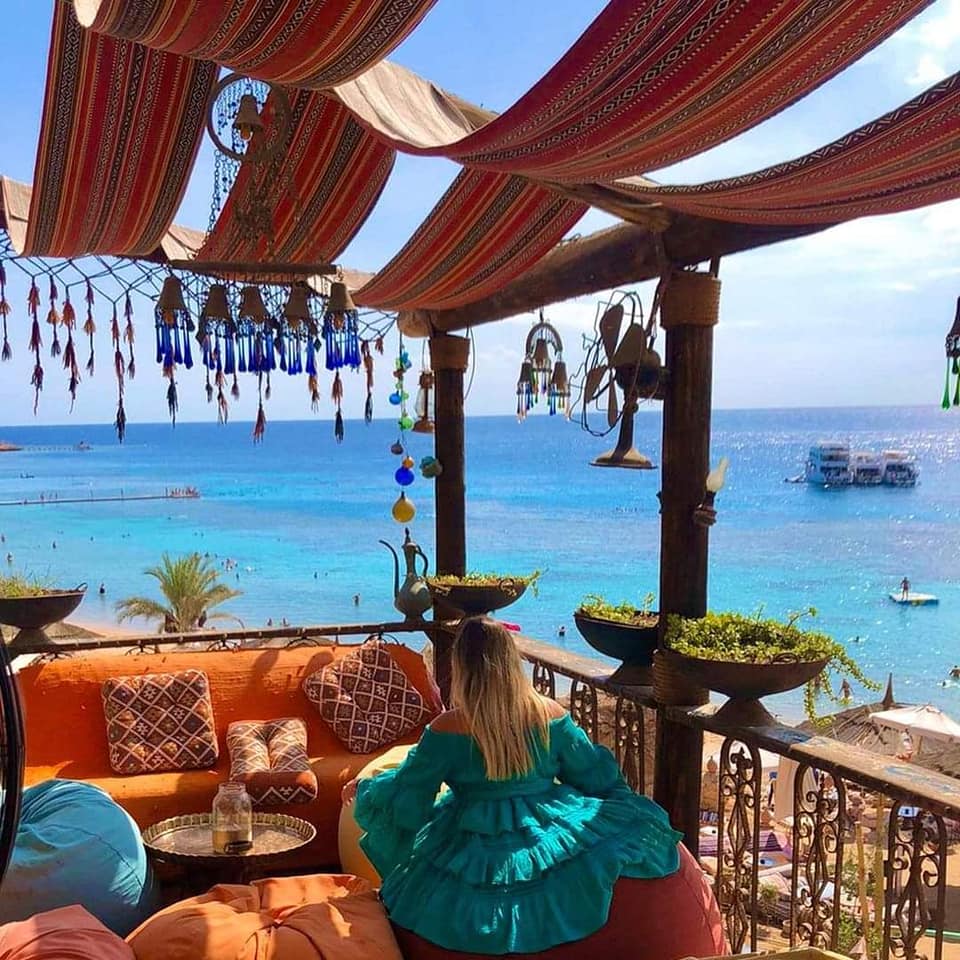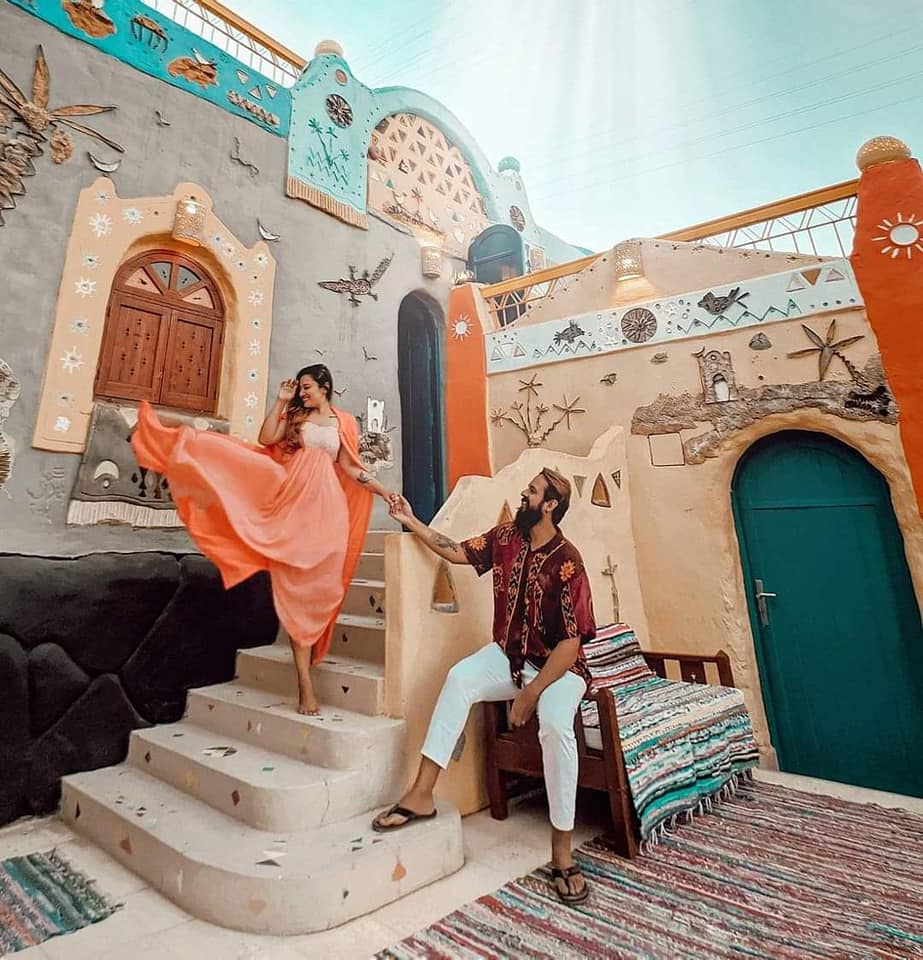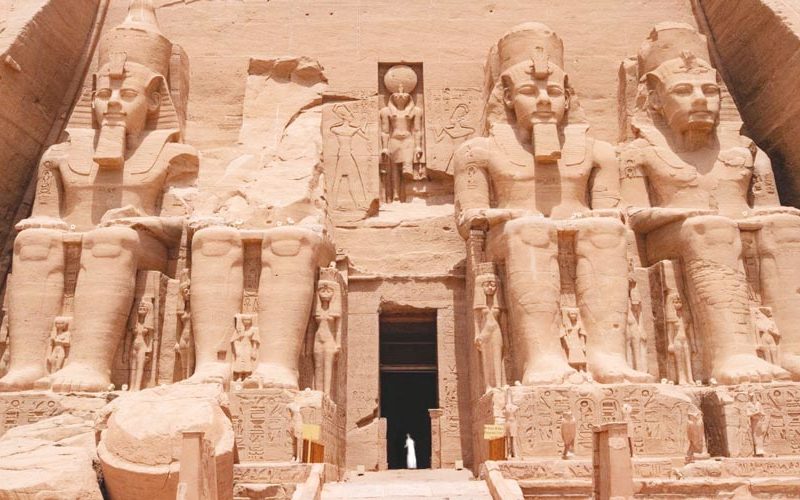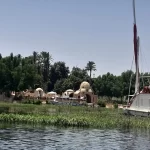11 Day
Upon Request
Your Hotel
16 Attractions
Tour Description
11 days Cairo and Nile Adventure dahabiya The mysterious beauty of Egypt by going on this Cairo and Nile Adventure. In this 11-day tour, wander in the capital city of the land of the pharaohs, Cairo. a Nile cruise from Luxor to Aswan on the golden pearl of the Nile, Dahabiya. The golden pearl will take you on a unique route, unlike any other cruise. Get to visit El Batekh Island, El Kab Village, Esna, Edfu, Gebel El Silsila, and much more.
Included
- Meet and greet service by our representatives at airports
- The assistance of our guest relations during your stay.
- All airport transfers by a private air-conditioned deluxe vehicle.
- Accommodation for 3 nights in Cairo including daily breakfast.
- Accommodation for 7 nights onboard Dahabiya on a full board basis.
- All sightseeing tours in Cairo – privately guided tours.
- All sightseeing tours on the cruise sharing Dahabiya group.
- All sightseeing tours in Cairo, Luxor, and Aswan as mentioned in the itinerary.
- Entrance fees to all sites as indicated on the itinerary.
- Tea, Coffee, and Soft Drinks during Meals on board your Dahabiya
- Egyptologist English-speaking tour guide during your tours.
- Lunch at a good quality local restaurant.
- Bottled water during your tours and transfers.
- All service charges and applicable taxes included
Not Included
- International Airfare
- Domestic airfare
- Any optional tours
- Personal spending
- Tipping
Tour Itinerary
Day 1: Arrival in Cairo - Welcome to the land of Pharaohs
Welcome to the land of Pharaohs

began 11 day Cairo and Nile Adventure dahabiya with our tour manager, who will meet and assist you at Cairo International Airport. and then he will escort you to your hotel by exclusive air-conditioned deluxe vehicle. At the hotel, the tour manager will assist you to have a smooth check-in and review your holiday itinerary with you to establish and confirm pick-up times for each tour.
Overnight in Cairo
Day 2: Visiting the Pyramids & Sankara
Giza Pyramids

After breakfast, you will be accompanied by your personal guide to Giza Plateau to visit the Great Pyramids of Giza. Cheops, Chefren, Mykerinus, and also the famous Sphinx and Valley Temple facing the great statue. There is an additional visit to the Solar Boat in front of Cheops Pyramid (extra ticket on the spot). The number one activity in Cairo is by far the Great Pyramids of Giza and the Great Sphinx. Dated almost 5000 years ago, these monuments and their great conservation state are one of
the greatest things you can experience with the naked eye. Located in the Giza Complex on the west side of the Nile River banks, the Great Pyramids and the Great Sphinx are Cairo’s best-kept treasures. It has many tombs. It consists of the great Giza Pyramids (Khufu, Khafre, and Mankaure), which are considered to be one of the seven wonders of the world, and Khufu Pyramid is considered to be the grandest in the complex... This complex also contains the amazing Sphinx and the Valley Temple.
The Great Pyramid
It's an astonishing engineering accomplishment, as it's the greatest pyramid that has ever been built. It was built by King Khufu. It contains about 2300000 blocks. These white Tura limestone blocks give the pyramid a smooth surface.
The Great Sphinx
It is the oldest known monumental sculpture in the world, All tourists come from around the world to witness the beauty of its shape (ahead of a man's head) and the body of a human, which has many spiritual and mythical meanings.
Lunch will be served in a good-quality restaurant

and then proceed to the Sakkara area to visit
Sakkara Complex

the first pyramid ever built. Djoser Pyramid. Then, move to Memphis; Old Kingdom's capital and famous Necropolis. Djoser’s Step Pyramid at Saqqara is one of the most important archeological sites in all of Egypt. While it may not be as impressive or as famous as the Giza Pyramids, this structure predates them,
and it is vital to archeologists’ understanding of the development of pyramid construction. The Step Pyramid was built in the 27th century BC, during the 3rd dynasty rule of Djoser. It is the first pyramid built in Egypt and while it is not a ‘true pyramid’ with smooth sides, like those at Giza and Dahshur, it remains an important stepping stone in their development. It is also the first large-scale cut-stone structure in the world.
The structure consists of six distinct layers, or steps, of diminishing size built on top of one another. Archeologists understand this to be an embellishment of earlier an earlier practices where pharaohs were buried under a mastaba, a flat rectangular structure somewhat like a large grave covering. Djoser’s builders decided to stack several of these structures to create a more imposing monument to the pharaoh, creating the structure we see today that stands 203 feet tall. In doing so, they took the first step toward the creation of the pyramids that have made Ancient Egypt famous throughout the ages.
Meals: Breakfast, Lunch.
Visits: Great Pyramids of Giza, Sphinx, Valley Temple.
Optional visit to Solar Boat, Sakkara Complex, Djoser Pyramid, Memphis.
The oldest structures in Cairo date back only to the last couple of centuries BC during the Greco-Roman period; however, on the fringes of the city stand the Giza Pyramids, some of the oldest structures on Earth. Despite their proximity to Cairo, the difference in age between the pyramids and the city itself is proof of their different histories.
The pyramids at Giza and elsewhere in the desert near Cairo are a part of the legacy of an older city and civilization that fell into decline long before Cairo was founded. This civilization named this area Memphis, which was the seat of power to the Old Kingdom (2686–2181 BC) of Ancient Egypt, home to the pharaohs that raised the pyramids.
day-3 : Cairo museum
Cairo museum
After having breakfast at your hotel in Cairo, you will be escorted by your private Egyptologist tour guide to visit

Centrally located on the edge of Tahrir Square in Cairo, the Egyptian Museum is hard to miss on any tour of Cairo. Opening in 1902, it was purpose-built to house the antiquities of Ancient Egypt. Inside is the greatest collection of Ancient Egyptian archeological history in the world. The Egyptian museum in Cairo houses over 120,000 artifacts, including the contents of Tutankhamen’s tomb
and most of the mummies that have been discovered since the 19th century. The museum’s exhibits span from the beginning of the Old Kingdom of Ancient Egypt (approximately 2700 BC) through the Greco-Roman period. The building consists of two floors. On the ground floor, you can follow the history of Egypt from the Old Kingdom up through the Greco-Roman period by turning left
at the entrance and looping around Lunch will be taken throughout the tour at a local restaurant. Then, continue driving to Islamic Cairo. where you will be able to explore Khan El Khalili, Cairo’s oldest bazaar.
Meals: Breakfast, Lunch.
Visits: Egyptian Museum, Islamic Cairo,

The bazaar is loud, crowded, colorful, and exciting—full of all kinds of goods and shiny baubles. You can find the typical tourist trinkets here, but don’t let them distract you from the genuinely fine shopping to be found here. There is a spice market where you can buy fresh spices of any variety. The perfume market is awash with countless blends of essential oils. Deeper into the market, there are gold vendors and antique shops full of interesting pieces.
Day 4: karnak temple and luxor temple
Fly to Luxor Cairo and Nile Adventure
Check out from your hotel in Cairo in the morning, then transfer to Cairo Airport for your flight to Luxor. where you will be met, assisted and then taken by an air-conditioned vehicle to embark on your cruise in Luxor East Bank at Noon and have lunch on board. You will go on a visit to the East Bank, where you will visit. the famous
Luxor Temple

Different than other temples in Luxor, the Luxor temple was not built in adoration of a god or to a god figure of the kings and pharaohs; instead, it was built in dedication to the rejuvenation of kingship. Many kings might have been crowned at the Temple of Luxor, whether crowned in reality or conceptually, as in the case of Alexander the Great, who claimed he was crowned at Luxor, although facts appear to indicate that he had never traveled south of Memphis, which is considered the modern city of Cairo.
Karnak Temple

The Karnak Temple dates back from around 2055 BC to around 100 AD. It was built as a cult temple and was dedicated to the gods Amun, Mut, and Khonsu. Being the largest building for religious purposes ever to be constructed, the Karnak Temple was known as the “most select of places” by ancient Egyptians. During the New Kingdom,
The Karnak Temple Complex was the center of the ancient faith while power was concentrated at Thebes (modern-day Luxor) and its significance is reflected in its enormous size. In addition to its religious significance, it also served as a treasury, administrative center, and palace for the New Kingdom pharaohs. It is to this day considered the largest temple complex ever constructed anywhere in the world.
Day 5: valley of the kings , Hatsheput temple and 2 colossal of memnon
Enjoy breakfast and then a visit to Luxor West Bank first
Valley of the kings

Start your day with an impressive breakfast meal, and then join our Egyptologist tour guide on a tour to visit the gorgeous Luxor tourist attractions, starting with Its royal burials are located in the West Bank of Luxor, which has 24 terrific royal tombs and
in total, 64 tombs, according to the last discovery at 2008 to 2014. It's the final resting place of Egypt's rulers from the 18th to the 20th dynasty; it is home to tombs including the great Pharaoh Ramses II and King Tutankhamun. The tombs were well stocked with all the material goods a ruler might need in the next world. Most of the decoration inside the tombs is still well-preserved.
Hatshepsut temple

It is a mortuary temple at Deir El-Bahri. It was built by Queen Hatshepsut, who is considered to be one of the most formidable women in Ancient Egypt. The queen is distinguished as one of the most successful pharaohs of Ancient Egypt, but she was not the only female ruler in Egypt's history. Her reign was peaceful and prosperous and as a result, it witnessed a wide variety of achievements one of them was her own mortuary temple which commemorates all her great works on its walls.
Colossi of Memnon

They are two incredible massive stone statues of the royal Pharaoh, Amenhotep III. They depict him in a seated position, and they are made from blocks of quartzite sandstone. The legendary Colossi of Memnon are the guardians of the Mortuary Temple of Amenhotep III. The temple consists of two spectacular twin statues sitting at the entrance of Luxor and it gained its fame due to its majestic appearance.
Have dinner onboard your cruise. Overnight aboard your cruise
Meals: Breakfast, Lunch, Dinner. Visits: Luxor West Bank.
Day 6: Esna Temple & Sailing to El Kab Village
Have an early morning crossing Esna lock with breakfast on board. After breakfast, go to visit
Esna Temple.

Dedicated to the ram-headed god Khnum (the god of creation), the construction of the Temple of Esna started during King Tuthmosis III's reign during the 18th Dynasty but the temple was completed construction during the Ptolemaic period and the Roman period between 40 and 250 A.D. Inscriptions on the temple wall nominate the important figures related to the creation of the Temple of Esna, also known as the Temple of Khnum.
The remains of the Temple of Esna contain a hall of columns with 24 pillars beautifully decorated with lotus floral capitals and palm capitals. The walls are covered with 4 rows of reliefs, showing Ptolemaic and Roman Emperors dressed in Pharaoh costumes, offering sacrifices to the god Khnum. There are chambers on both sides of the temple entrance that were used by the priests and keepers of the temple as storerooms.
Then, you will sail ahead to El Kab village around 1:00 PM. Enjoy a delicious lunch while sailing and have some tea time during the sunset. Have dinner on board. Overnight aboard your cruise near El Kab village. Meals: Breakfast, Lunch, and dinner Visits: Esna Temple.
Day 7: El Kab Temple and Sailing to Edfu
Edfu temple

The Temple of Horus at Edfu is widely considered to be the most impressive of all of the Nile-side temples along the journey between Luxor and Aswan. It is a required stop by all of the cruise ships that make the trip, also stopping at Esna and Kom Ombo. Like at Esna, the temple at Edfu is a late construction.
It was built during the Greco-Roman Period, but the builders painstakingly preserved the form of Egypt’s true pharaohs. As a result, a visit to Edfu allows you to see what all of the other ruined temples around Egypt might have looked like had they been built 2000 years later.
Day 8: Sail to Gebel El Silsila Cairo and Nile Adventure
Enjoy breakfast on board while sailing to Gebel El Silsila. Upon arriving, go on a visit to Gebel El Silsila after lunch. Then, enjoy a special BBQ dinner. Overnight aboard your cruise at Beshir Island. Meals: Breakfast, Lunch, and dinner. Visits: Gebel El-Silsila.
day 9 ; visit kom ombo temple
breakfast while sailing to Kom Ombo. Then, visit the famous
Kom Ombo Temple.

Along with Esna and Edfu, Kom Ombo is the third major stop that most of the Nile cruises between Luxor and Aswan make on their journey. Located only 30 miles north of Aswan, it is also easy to visit Kom Ombo on a day trip by car, however, the setting of this Temple of Sobek, the crocodile god, makes an approach by water the far superior way to visit this site.
The temple is perched atop a picturesque bluff alongside the river and while there are no longer any crocodiles in the river or in the sacred lake inside the temple complex, this riverside temple is still worthy of a visit. Like the other two sites between Luxor and Aswan, Kom Ombo dates from the Ptolemaic Dynasty and it was only completed under Roman rule. The temple has a dual dedication to Sobek.
as well as Horus, and the plan of the temple reflects this dual purpose. Then, sail to Herdiab Island. Enjoy a relaxing lunch at Herdiab Sand Beach, where you can have a swim and relish the amazing nature. Enjoy dinner on board while sailing. Overnight aboard your cruise near Aswan Bridge. Meals: Breakfast, Lunch, and dinner. Visits: Kom Ombo Temple, Herdiab Sandy Beach.
Day 10: farewell party on board
Philae Temple

breakfast on board during the sailing to Aswan. Go on unique Aswan excursions. This beautiful temple complex is one of the most picturesque in all of Egypt. It sits on Aglika Island, just south of the old Aswan Dam, and you must ride a water taxi to the island to get to the ruins. The temple was moved to its current location following the construction of the High Dam,
which threatened to submerge it permanently.
The reconstruction at the current site was carefully completed, painstakingly preserving the original appearance and layout of the complex and even landscaping the island to match its former location.
High Dam

When construction began on the High Dam in 1960, it was the most heralded part of President Gamal Abdel Nasser’s effort to develop Egypt for all Egyptians. While the dam is certainly not the largest in the world, it is an impressive engineering feat nonetheless, over 360 feet tall and 12,500 feet across. The dam was completed in 1971 and the huge reservoir behind it, named for President Nasser, finished filling in 1979.
then Have lunch onboard and a fabulous dinner and farewell party on board. Overnight aboard your cruise at Aswan West Bank. Meals: Breakfast, Lunch, and dinner. Visits: Aswan.
Day 11: Final Departure Cairo and Nile Adventure
Aswan airport

Breakfast on board, and then disembark and get transferred to Aswan Airport for your final departure via Cairo Airport. Meals: Breakfast
Pricing Policy
- 0 to 5.99 – Free.
- From 6 to 11.99 – 50% of the adult person.
- From 12 – will be treated as an adult and must pay the total price of the tour.
- If your travel package includes airfare, there may be an extra fee for each child accompanying you.
- The child policy applies to children who share rooms with their parents (maximum 2 child sharing the parents’ room under 12 years old)
- Reservations should be made as soon as possible.
- The payment of the total amount must be made at the time of booking confirmation and can be made by credit or debit card (Visa and Mastercard) via Verisign Secured system on our website
We don’t charge a cancellation fee for tours canceled for “force majeure” reasons, such as volcanoes, earthquakes, or other reasons. If the cancellation is due to personal or business reasons and we have already incurred costs on your behalf, these costs will be transferred to you.
- All our packages and tours of Egypt do not include entrance fees to special archaeological sites such as visiting inside the pyramids, the Museum where the Solar Boat is located in the pyramid area, or to enter the Tutankhamun tomb in the Valley of the Kings in Luxor.
- If you wish to visit one or all of these areas, please contact us by email as soon as possible, so that we can make the necessary arrangements.
- Tips are not mandatory. And a form of appreciation for the services provided.
- Whether you offer a tip or not, we thank you for choosing us to help you on your tour, and we hope we have pleased you.
- Read More about Tipping in Egypt
Frequently Asked Questions
To book a tour, you can visit the official website of the tour company or contact them directly through phone or email. Alternatively, you can use online booking platforms or visit a travel agency. Make sure to provide all necessary details such as preferred dates, number of participants, and any specific preferences to ensure a smooth booking process.
We offer tours in a variety of languages, including but not limited to English, Spanish, French, German, Italian, Chinese, Japanese, Russian, and Arabic. If you require a tour in a specific language, please feel free to inquire, and we will do our best to accommodate your needs.
The most widely accepted currency on this tour is the US dollar. While local currencies may also be accepted in certain locations, carrying US dollars as a backup is advisable to ensure smooth transactions throughout the tour.
Yes, we accept payment by credit card.
Tipping is not included in the tour price. It is customary to tip tour guides and other service providers in the tourism industry as a gesture of appreciation for their services.


